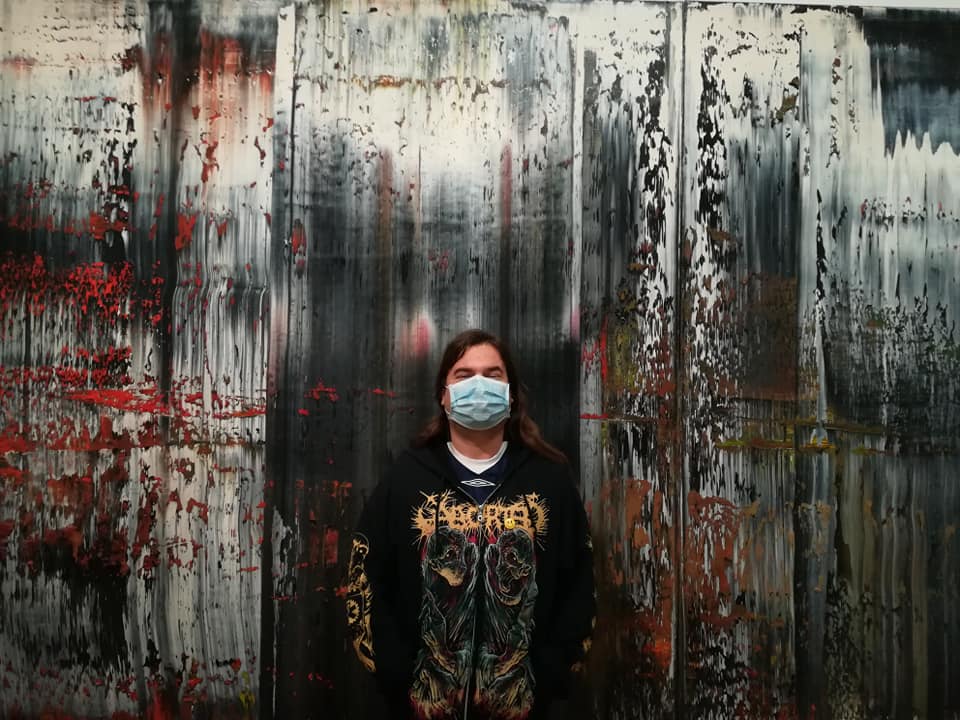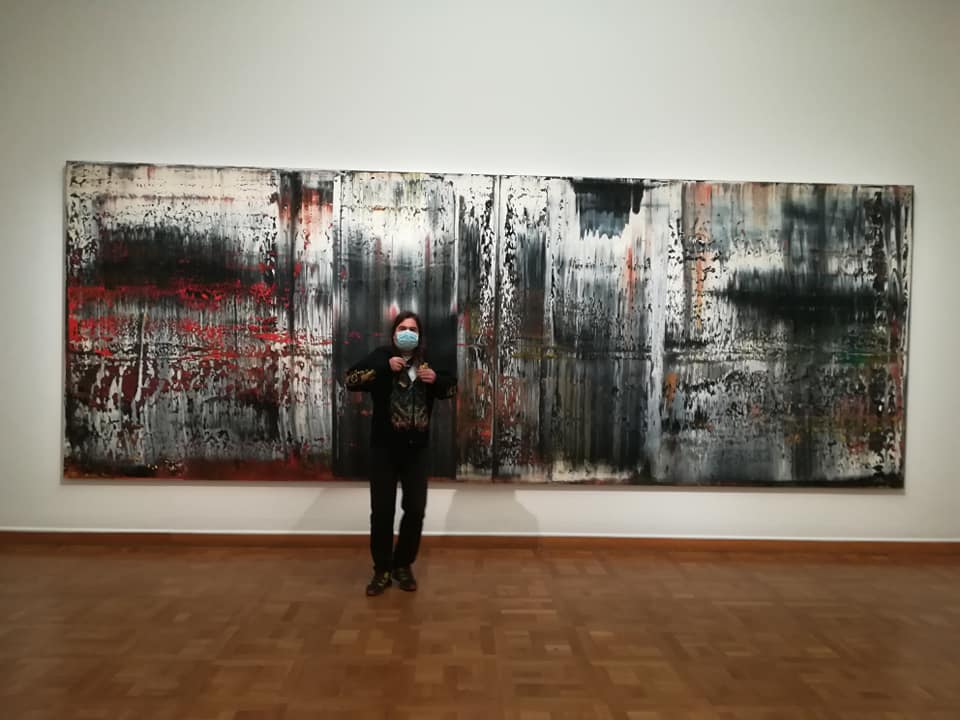I melt back into indifference
Napalm Death, Silence Is Deafening
Nobody I know is fond of Gerhard Richter. Yet, at least since the turn of the new millennium, Gerhard Richter ranks in the very top segment of best-selling and most influential living artists. That is to say, he is to be considered as a distinctly defining figure of present-day art. Abstract Expressionism had been one of the intellectual peaks in the history of Western art. Its abstractions are meant to express the spiritual, the divine, the gloriousness of mind, they are also meant to be an investigation into the nature of art and painting and the possibilities of methods; Ad Reinhardt`s black paintings assembled within the line of an heroic quest for the „last“ possible paintings. That was in the 1950s and 1960s. In the 1970s, Gerhard Richter came up with his monochromous grey paintings. They are solely meant to express „indifference, shapelessness and refusal to give evidence“. They are meant to mean nothing. Salvador Dali says: Genius spiritualises everything. Yet, how would you spiritualise indifference? Much more than Reinhardt´s black paintings Richter´s grey paintings may be „last“ possible paintings, though rather in the sense of marking the beginning of something new. The limits of human thought and expression, therefore also the possibility of seomething new that lurks behind the horizon can be spiritualised (i.e. via the black paintings), yet indifference may open a much wider and plainer ground, with countless possibilities of exploration; since it may operate at a much lower level and standard of quality. Says Richter: I pursue no objectives, no system, no tendency; I have no program, no style, no direction. I have no time for specialised concerns, working themes, or variations that lead to mastery. I steer clear of definitions. I don´t know what I want. I am inconsistent, non-commital, passive. I like the indefinite, the boundless; I like continual uncertainty. That could translate: I´m a pretty average mind. I am a drifter whose morale will largely will be determined by circumstances. I do not try to erect something and transgress the frontiers that are set by contemporary understandings, etc. In Leonardo da Vinci you also had the indefinite, boundlessness and uncertainty, yet Leonardo was operating way beyond the intellectual frontiers of his time. The radical and the transcendent mind will be prone to the indefinite and to experimental uncertainty – and the objective of art should be to open up the mind and the potential of the mind for transcendence. This is what you had in modern art. Contemporary art is more confusing. What you may have in post-modern, or contemporary art is general consensus of indifference. Alongside with his grey paintings, Gerhard Richter, at least symbolically, opened the gates to hell.

Of course, Gerhard Richter is not stupid. Even less, he´s devilish. His qualities are undeniable. Gerhard Richter is raumgreifend, he has Volumen, his oeuvre is of „oddly integral diversity“. He has done abstract paintings, landscapes, portraits, the RAF cycle, church windows, overpaintings. Despite not being avant-garde, he always manages to be at the pulse of time, at least with some delay, that nevertheless, may put more gravity into the whole thing. His art is both realistic and illusionistic. Consider also that Richter is a hybrid between a painter and a conceptual artist. He often presents us paintings that are outtakes or snapshots of reality, without, however, spiritualising them as a fragment that alludes a greater whole, that adresses your imagination of what could be beyond these outtakes, no: you are simply confronted with a rather meaningless snapshot and outtake. Some of Richter´s depictions of clouds, landscapes and seascapes are quite immersive. The objective, however, is to de-romanticise nature, to remind us that romantic notions about nature and the world we inhabit are in the eye of the beholder at best, and not qualities inherent to nature itself. Yet a quality inherent to art and painting is to romanticise nature and to offer higher perspectives, a more sophisticated, empathetic worldview; to elevate not only nature, but also man as the beholder. Occasionally, Richter´s abstract paintings are quite tasty. They combine elements of geometric abstraction and gestural abstraction and his signature style is that he uses a squeegee to make his paintings more interesting. In his RAF paintings there is a mild uncanniness, a mildly non-conformist confrontation of the Bundesrepublik with its past. Richter painted the RAF cycle ten years after the events, in the later 1980s. He has also painted church windows. The respective archbishop did not like them. Gerhard Richter is no slouch. He is, undeniably, a talent and he is academic. There are things that can be said about his art, though not very much. The possibilities of things to be said about his art get drained rather sooner than later. He may not care so much on that behalf, since with his art he is among the 500 most wealthy individuals in Germany. He does not appear an uncomfortable or unlikeable person. It is said he is taken by surprise by the success of his art himself. Consider that one of Richter´s most iconic paintings – Betty (1988) – depicts a woman turning away from the viewer to gaze at a monochromous painting (respectively a monochromous background). It depicts a woman from behind. Despite its solidity and tastyness it is a negative icon. It is an icon of negativity. It is an icon of lukewarm interest, close to being an icon, again, of indifference. – Despite that, it´s an icon. Richter said, it was not easy to overcome Beuys. It will neither be easy to overcome Richter. Richter has Volumen and there is intellectual presicion in his oeuvre, even some space for enigma and mysticism. Upon reflection, Richter´s work and attidute may serve as a watershed between what is possible in art, and via art, and what is not. Maybe that is its historic function. He (at least symbolically) opened the gates to purgatory, the flat land of nearly infinite space, of indifference and mediocrity in art, the flat land we currently inhabit. That nobody I know is fond of Gerhard Richter may just be reflected in his status as the defining artist of our time.
If you like to think about art in a lofty way, you may consider Gerhard Richter and his ineffective art as the enemy. Yet ineffectiveness is inherent to art. Self-criticism about its own relative impotence and incompetence is inherent to art. The problem arises when affirmation of ineffectiveness becomes the substance of art. Yet as such, as the description of the spirit of our age, our present days may go into history´s books: as „the Age of Gerhard Richter and Damien Hirst“. The history of art and of painting had been sensational, and sensationally progressive, for, say, two centuries. (Normally, cultural peaks and climaxes are geographically clustered and last for a generation or two). Naturally, a point will come when all will be said and done in a discipline for quite a while, and it maybe should not come as a surprise that painting had suddenly collapsed in exhaustion, that there had been a big and sudden slump after the radicalities of Abstract Expressionism, Arte Povera and Fluxus. All seemed to be said and done. Pop Art seemed the last occasion to erect distinct icons that capture the contemporary era. Pop Art already was a bit stupid. After the 1960s, society will have become too differentiated and too intelligent for art, to be captured by the means and the spirit of art. The spirit of avant-garde, even art itself, seemed to have become the anachronism in relation to society. The grace that had fallen upon art and, notably, the spirit of avant-garde in the 19th and 20th century maybe had only been the grace of the low hanging fruit. In those bygone days, art could more easily master to be more intelligent and futuristic than society, since society was so stupid. More recently, society may have become too intelligent for art. – Yet also, and most obviously, art has become more stupid and self-defeating, self-depreciating than ever before. That semi-competent artists like Richter, Baselitz, Damien Hirst or Jeff Koons are the defining artists of our age is symptom of a malaise. I don´t know why artists aren´t more intelligent and commited nowadays. Although there are ebbs and floods in the availability of competent people you would also guess that a certain stock of very intelligent and creative truth-seekers are around all the time. The secret of art, and of any enterpise that lies within the mind, is that it is not actually determined by society and Zeitgeist. It´s an enterprise of plunging into depths, of transgression. Despite its insight into its own ineffectiveness, art is meant to be a protest against the ineffectiveness of art. Its purpose should be to erect something. It is, above all, a matter of inspiration. Inspiration is practically independent from society and Zeitgeist. So why isn´t there more inspiration, contemporarily? Yet life, as they say, never ceases to be a mystery.

There´s a Richter exhibition in Vienna right now. Just by the end of this week, the new annual ranking list of most important living artists has come in. Again, Gerhard Richter ranks on top of them all. Yet the ranking mentions also shooting stars and artists that can be expected to have a bright future. I need to look at them. After all, Gerhard Richter is also one of the defining artists of postmodernism, i.e. not necessarily one of the defining artists of the actual present or the future to come. Yet postmodernism at least had a conceptual framework. And there is no guarantee that present and future will have even that, i.e. a minimal insight and self-understanding of what it is doing. Maybe we will lose even that. Maybe it gets even worse than that. Also the Rolling Stone magazine most recently published an update of its list of the 500 greatest albums of all time. Sgt. Pepper´s Lonely Hearts Club Band got kicked back at postion 24, Elvis Presley has not even an album in the top 50 anymore. Marvin Gaye with his elevator music on What´s Going On is now King, is now President, like Gerhard Richter. I think what is going on in this world is that most people simply are directionless. Also as concerns popular art, popular music, which has clearly been going down the roller coaster (including death metal, which, to my great dissatisfaction, has even become moronic more recently). Yet there are also good things. Two weeks ago I discovered Billie Eilish. I admit that I have not been pretty observant in this respect, but she strikes me as the best thing I have seen in more mainstream popular music in the new millennium. She has synesthesia and her videos are great. I see her in a crown. Her debut album has already been included in the Rolling Stone´s list of the 500 greatest albums of all time. Maybe the Generation Z will push us forward again. Meanwhile, we seem to be able to live off the fat of older generations, and maybe even for a long time to come. Gerhard Richter or Damien Hirst aren´t actually the most expensive artists. The most expensive paintings sold at auctions in the last decade were from van Gogh, Modigliani, and Basquiat. I.e. the center of gravity is still where it should be. The world is still stable and logical. This is so because the structure of the world is chaosmos, as I always emphasise.
Oct. 16-18, 2020
